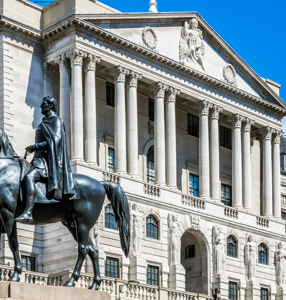The Bank of England decided against raising interest rates in September, voting by a narrow majority to keep the policy rate unchanged at 5.25%. This marked the first time that interest rates have not risen since December 2021. Although CPI inflation remains well above the Bank’s target, several measures of price pressures cooled more quickly than had been expected in August. Inflation remains on course to fall over the rest of the year, but further rate rises cannot be ruled out just yet, particularly if pay growth manages to sustain its historic pace.
Tightening cycle put on pause as inflation delivers rare downside surprise
The Bank of England’s Monetary Policy Committee (MPC) voted to leave interest rates unchanged in September, holding Bank Rate at 5.25%. In doing so, the MPC halted (at least for now) a tightening cycle that stretches back almost two years.
This followed the news that annual CPI inflation had nudged down to 6.7% in August (from 6.8% in July), confounding consensus expectations of an uptick to 7.0%. A surge in motor fuel prices, coupled with the introduction of new alcohol duties, had been expected to push headline inflation back up in August.
Even more striking than headline fall in inflation was the deceleration in services inflation, a key indicator of domestic price pressures for the MPC. In August, the services measure fell back to 6.8% (from 7.4% in July), comfortably below the Bank’s forecast of 7.2%.
But the MPC’s decision to pause was very finely balanced, with the Committee split 5-4 in favour of keeping rates on hold. Indications of weaker activity and disinflationary momentum were sufficient to convince some of the MPC’s hawkish contingent to keep interest rates unchanged this month, alongside an explicit acknowledgement that the current policy stance was restrictive.
Those in the minority (i.e. the members that voted for another 25 basis point rate rise) put more weight on more positive forward-looking indicators of output, and a still-tight labour market. In particular, the persistent strength in private sector wage growth – another closely-watched measure of domestically-generated inflationary pressure – was undiminished in the latest data, pointing to the risk that inflation expectations remain undesirably elevated.
Inflation is on downward trajectory but tighter financial conditions are here to stay
Most analysts expect the MPC’s latest announcement to mark the end of the Bank’s tightening cycle. However, the MPC appear to have left the door open to further rate rises, with their forward guidance largely unaltered: “further tightening in monetary policy would be required if there were evidence of more persistent inflationary pressures”.
Notably, the suggestion that policy would have to remain restrictive for an extended period of time (“sufficiently restrictive for sufficiently long”) also remained in place. This makes it unclear if rates will be cut any time soon, as financial markets still expect. As in the recent past, the decisions around monetary policy are likely to be heavily dictated by movements in activity and domestic price pressures.
Looking ahead, we expect headline inflation to continue falling over the rest of the year, as base effects in food, fuel and energy unwind. Cooling pipeline pressures will pass through to lower goods inflation, while emerging labour market slack should exert downward pressure on wage growth and services inflation. However, the recent uptick in global oil and domestic fuel prices suggests that the path back down may be bumpier than previously expected.
CBI surveys also show that business’ expectations for price growth over the next three months have stabilised at their lowest level since April 2021. Lower annual growth rates notwithstanding, our members continue to report that costs still pose a significant challenge to their businesses.










